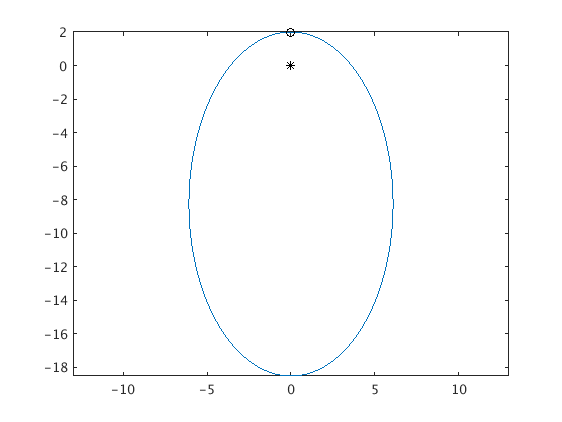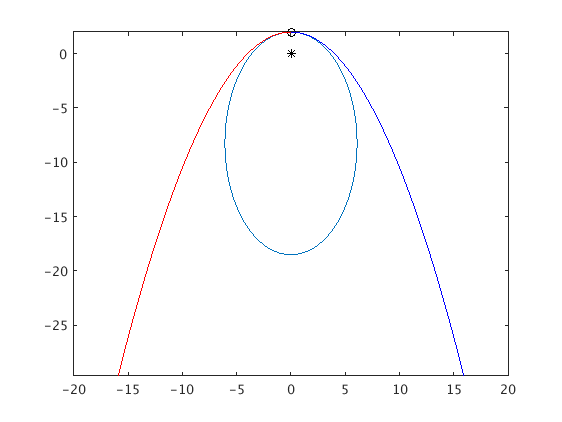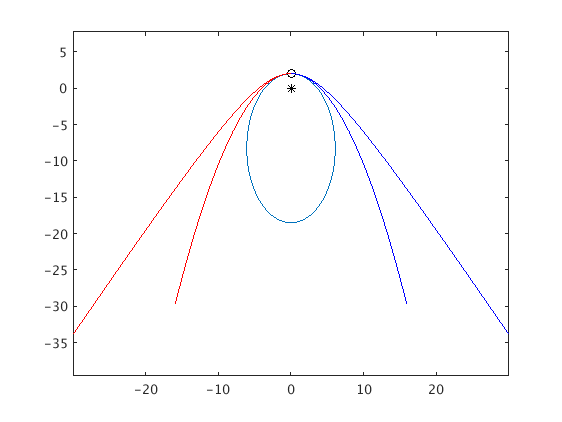Motion in earth's gravity
Contents
Law of gravity
Assume the center of the earth is at the origin, and a spacecraft has position y=(y1,y2) at time t. Then the force from gravity is directed at the earth, and the magnitude is proportional to 1/d^2 where d is the distance to the center of the earth.
Hence the force vector is -C*y/||y||^3 = -C*y/(y1^2+y2^2)^1.5
Newton's law
Newton's law states that mass*acceleration is the sum of all forces acting on the mass.
If the spacecraft has position (y1(t),y2(t)) at time t, the acceleration vector is (y1''(t),y2''(t)).
Hence the functions y1(t), y2(t) satisfy the following system of ODEs:
y1'' = -c*y1/(y1^2+y2^2)^1.5 y2'' = -c*y2/(y1^2+y2^2)^1.5
We will use c=1 for simplicity from now on.
This is a system of 2nd order ODEs. We need an initial condition for the initial position and for the initial velocity: E.g., assume we are a distance of 2 from the origin, and have an initial speed of 0.95 in tangential direction:
(y1(0),y2(0)) = (0,2) , (y1'(0),y2'(0)) = (0.95,0)
Rewriting the problem as a first order ODE system
We introduce additional functions y3(t):=y1'(t) and y4(t):=y2'(t).
Now we obtain the following first order ODE system for y1(t),y2(t),y3(t),y4(t):
y1' = y3 y2' = y4 y3' = -y1/(y1^2+y2^2)^1.5 y4' = -y2/(y1^2+y2^2)^1.5
We can therefore write the ODE system as y' = f(t,y) with the following function f(t,y):
f = @(t,y) [ y(3); y(4); -y(1)/(y(1)^2+y(2)^2)^1.5; -y(2)/(y(1)^2+y(2)^2)^1.5 ];
Low initial speed
First we use an initial speed of v=0.95. The solution is periodic in time, and the trajectory is an ellipse where one of the foci is the center of the earth.
opt = odeset('RelTol',1e-10,'AbsTol',1e-10); % use higher accuracy for ode45 [ts,ys] = ode45(f,[0 300],[0;2;0.95;0],opt); plot(ys(:,1),ys(:,2)); axis equal; hold on % plot trajectory in the (y1,y2) plane plot(0,0,'k*',0,2,'ko') % mark the center of earth with '*' % and the initial point with 'o'

Medium initial speed
Now we use an initial speed of v=1. The trajectory is a parabola where the focus is the center of the earth.
We first solve the ODE for t going from 0 to 100 and plot this in blue.
Then we solve the ODE backward in time, with t going from 0 to -100 and plot this in red.
v = 1; [ts,ys] = ode45(f,[0 100],[0;2;v;0],opt); % Solve ODE for t=0...100 plot(ys(:,1),ys(:,2),'b'); [ts,ys] = ode45(f,[0 -100],[0;2;v;0],opt); % Solve ODE backwards for t=0...-100 plot(ys(:,1),ys(:,2),'r');

High initial speed
Now we use an initial speed of v=1.05. The trajectory is a hyperbola where one of the foci is the center of the earth.
Again, the solution for t from -100 to 0 is shown in red, and for t from 0 to 100 is shown in blue.
v = 1.05; [ts,ys] = ode45(f,[0 100],[0;2;v;0],opt); plot(ys(:,1),ys(:,2),'b'); [ts,ys] = ode45(f,[0 -100],[0;2;v;0],opt); plot(ys(:,1),ys(:,2),'r'); hold off
